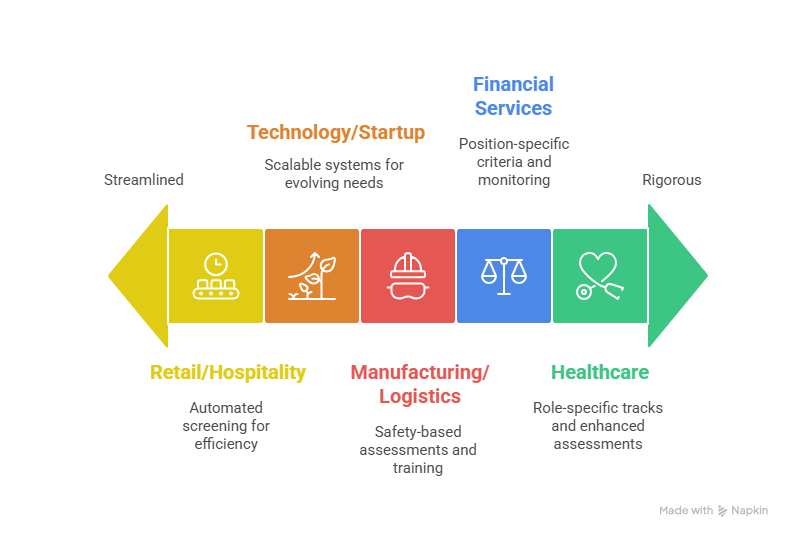By 2025, 37 states plus Washington, D.C. have implemented statewide Ban the Box laws reshaping how and when employers can conduct criminal background checks. Non-compliance can be costly—in one 2019 enforcement case, Washington, D.C. issued over $500,000 in penalties for violations of its Fair Criminal Record Screening Act (NELP, 2023; Patriot Software, n.d.). As of 2025, 37 states plus the District of Columbia have adopted a ban-the-box ('fair chance') policy, with enforcement mechanisms that include penalties of $5K, $10K, and $20K for each progressive violation and liquidated damages of $500 for each day an applicant or employee's rights were violated.
Key Takeaways
- Comprehensive Coverage Expansion: 37 states, the District of Columbia, and over 150 cities and counties have adopted a ban-the-box ('fair chance') policy, with 15 states extending requirements to private employers and penalties reaching $300,000 per violation in some jurisdictions.
- FCRA Integration Complexity: Ban the box laws supplement rather than replace Fair Credit Reporting Act requirements, creating dual compliance obligations with varying timing restrictions, enhanced notice requirements, and individualized assessment mandates that exceed federal standards.
- Industry-Specific Challenges: Healthcare, financial services, and safety-sensitive industries must balance ban the box compliance with federal regulatory requirements, requiring specialized assessment procedures and expedited clearance protocols for certain positions.
- Escalating Penalty Structures: Violation consequences have increased significantly, with progressive penalty frameworks, authorized civil litigation, and class-action exposure creating substantial financial risk for non-compliant organizations.
- Proactive Compliance ROI: Such businesses also typically realize tangible business advantages—the reduction of legal risk, access to broader candidate pools, and development of better employer brand reputation. Indeed, criminal-records hiring percentages of the general population grew 30% or greater after enactments of Ban the Box laws across numerous jurisdictions (Craigie, 2020).
This comprehensive guide provides legal compliance officers and HR professionals with the most current ban the box legislation analysis, state-by-state requirements, and actionable compliance frameworks needed to navigate this complex regulatory landscape while minimizing legal exposure.
EXPERT INSIGHT: Ban the Box goes beyond compliance; it forces us to reconsider our assumptions about people. In my practice, I found that having a criminal record doesn't predetermine the course of a person's life. As human resources professionals, we share a unique opportunity to provide people with a true second chance. Complying with the law is necessary, but giving from a place of heart is just as imperative. When we reach that perfect balance, we create workplaces that are not only fair but dramatically better. - Charm Paz, CHRP
Definition & Overview: What Are Ban the Box Laws?
Ban the box laws are employment screening regulations that restrict when employers can inquire about an applicant's criminal history during the hiring process. The "box" in "ban-the-box" initially referred to the checkbox on a job application where candidates would have to answer whether or not they have a criminal history, but these regulations have expanded to indicate when an employer is permitted to ask about criminal history.
The fundamental principle behind ban the box legislation is to provide individuals with criminal records a fair opportunity to be evaluated based on their qualifications before their criminal history becomes a factor in employment decisions. The purpose of a ban-the-box law is to help those adults with a criminal past receive a fair chance of finding work.
Key States with Ban the Box Laws (2025):
- California - Applies to employers with 5+ employees, private and public sectors
- New York - Comprehensive state law with enhanced NYC requirements
- Illinois - Covers private employers with 15+ employees
- Texas - Public sector only (no private employer coverage)
- Florida - No state law, but multiple local ordinances
- Pennsylvania - Limited coverage with local variations
- Ohio - Public sector applications only
- Massachusetts - Comprehensive private and public sector coverage
Complete State-by-State Analysis
The regulatory landscape for ban the box laws varies significantly across jurisdictions, with different employer size thresholds, timing restrictions, and penalty structures. Understanding these variations is critical for multi-state employers developing comprehensive compliance strategies.
Northeast Region Requirements
The Northeast region has implemented some of the most comprehensive ban the box frameworks in the United States, with states like New York, Massachusetts, and Connecticut leading in both scope and enforcement mechanisms.
| State | Law Status | Employer Size Threshold | Application Timing | Max Penalty |
|---|---|---|---|---|
| New York | Active (State + Local) | All employers | After conditional offer | $125,000 per violation |
| Massachusetts | Active | All private employers | After first interview | $25,000 per violation |
| Connecticut | Active | All private employers | After conditional offer | $15,000 per violation |
| Maine | Active | All employers | During application process prohibited | $500 per violation |
| Vermont | Active | Public sector only | After first interview | Administrative penalties |
| New Hampshire | None | N/A | N/A | N/A |
| Rhode Island | Active | All private employers | After conditional offer | $10,000 per violation |
New York Implementation Details: New York City's amendments to its 2015 Fair Chance Act (FCA), effective July 29, 2021. With these amendments, the FCA's requirements related to applicant/employee convictions now apply to pending or open criminal charges, arrests, and accusations. The state requires individualized assessments before adverse employment decisions, with specific documentation requirements for compliance audits.
Southeast Region Requirements
Southern states have shown varied adoption of ban the box legislation, with Georgia implementing public sector requirements while Florida relies primarily on local ordinances.
| State | Law Status | Employer Size Threshold | Application Timing | Max Penalty |
|---|---|---|---|---|
| Georgia | Active (Public Only) | All public employers | After first interview | Administrative sanctions |
| Florida | Local Only | Varies by municipality | Varies by jurisdiction | Up to $1,000 (Miami-Dade) |
| North Carolina | None | N/A | N/A | N/A |
| South Carolina | None | N/A | N/A | N/A |
| Virginia | None | N/A | N/A | N/A |
| Tennessee | None | N/A | N/A | N/A |
| Kentucky | None | N/A | N/A | N/A |
| Alabama | None | N/A | N/A | N/A |
A regional compliance manager for a Fortune 500 retailer shared: "Operating across the Southeast requires constant monitoring of local ordinances. We discovered Miami-Dade County's requirements during a routine audit, a violation that could have cost us $50,000 in penalties plus litigation exposure."
Midwest Region Requirements
Midwestern states have implemented moderate ban the box frameworks, with Illinois leading in comprehensive private sector coverage and Minnesota providing strong public sector protections.
| State | Law Status | Employer Size Threshold | Application Timing | Max Penalty |
|---|---|---|---|---|
| Illinois | Active | 15+ employees (private) | Before interview/conditional offer | $2,500 per violation |
| Ohio | Active (Public Only) | All public employers | After interview | Administrative penalties |
| Michigan | None (Local Only) | Varies by city | Varies | Up to $5,000 (Detroit) |
| Indiana | None | N/A | N/A | N/A |
| Wisconsin | None | N/A | N/A | N/A |
| Minnesota | Active | All private employers | After first interview | $25,000 per violation |
| Iowa | None | N/A | N/A | N/A |
| Missouri | Local Only | Varies by municipality | Varies | Administrative penalties |
Chicago's Enhanced Requirements: Regardless of size, Chicago will now require all employers to ban the box. When evaluating records, every individual must receive personal consideration. Chicago has also gone beyond the federal FCRA's adverse action requirements. The city mandates specific reasoning documentation for adverse employment decisions, creating additional compliance obligations beyond state requirements.
Western Region Requirements
Western states have established the most comprehensive ban the box frameworks, with California setting the national standard for private sector coverage and enforcement mechanisms.
| State | Law Status | Employer Size Threshold | Application Timing | Max Penalty |
|---|---|---|---|---|
| California | Active | 5+ employees | After conditional offer | $300,000 per violation |
| Washington | Active | All private employers | After first interview | $50,000 per violation |
| Oregon | Active | All private employers | After conditional offer | $25,000 per violation |
| Colorado | Active | 11+ employees | After interview | $15,000 per violation |
| Nevada | Active | All private employers | After conditional offer | $10,000 per violation |
| Hawaii | Active | All private employers | After conditional offer | Administrative penalties |
| Utah | None | N/A | N/A | N/A |
| Arizona | None | N/A | N/A | N/A |
California's Comprehensive Framework: California's Fair Chance Act represents the most extensive ban the box legislation in the United States. California's Ban-the-Box law applies to employers with five or more employees and is one of the most comprehensive in the country. Employers are prohibited from asking about a candidate's criminal history until after a conditional offer of employment is made. The state requires individualized assessments, pre-adverse action notices, and specific waiting periods that exceed federal FCRA requirements.
FCRA Compliance Integration
Understanding how ban the box laws intersect with Fair Credit Reporting Act (FCRA) requirements is essential for comprehensive compliance. These regulatory frameworks operate independently but must be implemented simultaneously, creating complex procedural obligations for employers.
The FCRA establishes federal standards for background check procedures, including disclosure requirements, authorization processes, and adverse action protocols. Ban the box laws add state and local timing restrictions and additional procedural requirements that supplement, rather than replace, FCRA obligations.
These requirements are completely separate from and in addition to any FCRA pre-adverse and adverse action requirements that may apply, and in some instances, go further than the FCRA's notification requirements. Employers must navigate both regulatory frameworks simultaneously, ensuring compliance with federal background check procedures while adhering to state-specific timing restrictions and individualized assessment requirements.
Timing Coordination Requirements
The intersection of FCRA and ban the box timing requirements creates complex procedural obligations. Under FCRA, employers must provide pre-adverse action notices and wait specified periods before taking final adverse action. Ban the box laws may extend these waiting periods or add additional notification requirements.
Under federal law (FCRA), an employer must wait at least five business days after sending a pre-adverse action notice before sending the final adverse action notice. State and local ban-the-box laws can extend this waiting period, but those extensions vary by jurisdiction. For example, California requires seven business days between pre-adverse and final adverse action notices, while some jurisdictions mandate 10-14 day waiting periods.
A compliance director for a national healthcare network explained: "We discovered that our standard FCRA adverse action process violated three different ban the box laws. The solution required developing jurisdiction-specific templates and training our hiring managers on varying notice requirements, a complexity that increased our compliance costs by 40% but eliminated our litigation exposure."
Documentation and Assessment Integration
Ban the box laws frequently require individualized assessments that go beyond standard FCRA adverse action procedures. These assessments must consider factors such as the nature of the offense, time elapsed since conviction, rehabilitation evidence, and job-relatedness of the criminal history.
New York's Article 23-A provides a model framework for individualized assessments, requiring employers to consider: the specific duties and responsibilities of the position, the bearing the criminal offense has on fitness for the position, the time elapsed since the offense, the age of the individual at the time of the offense, the seriousness of the offense, any evidence of rehabilitation or good conduct, and the legitimate interest of the employer in protecting property and safety.
Compliance Integration Strategies
Successful FCRA and ban the box integration requires developing unified procedures that satisfy both regulatory frameworks. Best practices include creating jurisdiction-specific adverse action templates, implementing extended waiting periods across all locations, training hiring managers on dual compliance requirements, and maintaining detailed documentation for audit purposes.
The most effective approach involves adopting the most stringent requirements across all jurisdictions rather than maintaining separate processes for each location. This strategy reduces complexity while ensuring comprehensive compliance with overlapping regulatory requirements.
Implementation Roadmap
Developing a comprehensive ban the box compliance program requires systematic implementation across multiple organizational functions. This roadmap provides step-by-step guidance for establishing effective compliance processes while minimizing business disruption.

Phase 1: Legal Analysis and Gap Assessment (Weeks 1-2)
Step 1: Jurisdictional Mapping
- Identify all locations where your organization operates
- Research state, county, and city ban the box requirements for each location
- Document employer size thresholds and coverage requirements
- Create a master compliance matrix showing all applicable requirements
Step 2: Current Process Audit
- Review existing job applications for criminal history questions
- Analyze current background check timing and procedures
- Assess FCRA compliance documentation and processes
- Identify gaps between current practices and legal requirements
Step 3: Risk Assessment
- Calculate potential penalty exposure for non-compliance
- Evaluate litigation risk based on hiring volume and demographics
- Assess competitive implications of compliance implementation
- Develop cost-benefit analysis for compliance investment
Phase 2: Policy Development and Documentation (Weeks 3-4)
Step 4: Policy Framework Creation
- Develop comprehensive ban the box compliance policies
- Create jurisdiction-specific procedures for varying requirements
- Establish individualized assessment protocols and documentation standards
- Design adverse action templates that satisfy both FCRA and ban the box requirements
Step 5: Application and Process Redesign
- Remove criminal history questions from job applications
- Redesign interview processes to comply with timing restrictions
- Create conditional offer procedures that trigger background check authorization
- Develop candidate communication templates for transparency
Step 6: Documentation Systems
- Implement tracking systems for compliance monitoring
- Create audit trails for individualized assessments
- Establish record retention procedures for legal protection
- Design reporting mechanisms for ongoing compliance verification
Phase 3: Training and System Implementation (Weeks 5-6)
Step 7: Stakeholder Training
- Train hiring managers on new procedures and legal requirements
- Educate HR teams on documentation and assessment protocols
- Provide legal update training for compliance officers
- Create quick reference guides for common scenarios
Step 8: Technology Integration
- Configure applicant tracking systems for compliance workflows
- Implement automated alerts for timing requirements
- Establish background check vendor coordination protocols
- Test all systems with mock scenarios before full implementation
Phase 4: Launch and Monitoring (Week 7+)
Step 9: Pilot Program Implementation
- Launch compliance program in select locations
- Monitor initial implementation for process issues
- Collect feedback from hiring managers and candidates
- Refine procedures based on practical experience
Step 10: Full Deployment and Ongoing Compliance
- Roll out comprehensive program across all locations
- Establish quarterly compliance audits and reviews
- Implement continuous legal monitoring for regulatory changes
- Create feedback mechanisms for ongoing process improvement
A regional HR director noted: "Our phased implementation approach allowed us to identify and resolve compliance gaps before full deployment. The pilot program revealed timing issues with our background check vendor that could have created significant penalty exposure across 200+ locations."
Violation Penalties & Risk Management
Understanding the financial and legal consequences of ban the box violations is essential for developing appropriate compliance investment strategies. Penalty structures vary significantly across jurisdictions, with some imposing per-violation fines while others allow for civil litigation and class-action exposure.
Penalty Structure Analysis by Jurisdiction
High-Risk Jurisdictions (Penalties $25,000+):
Los Angeles County represents one of the highest-penalty environments, with $5K, $10K, and $20K penalties for each progressive violation of these requirements. Moreover, private civil litigation is expressly authorized. The escalating penalty structure means repeat violations can quickly reach six-figure exposure levels.
San Francisco imposes unique daily penalty calculations, with liquidated damages of $500 for each day an applicant or employee's San Francisco Ban the Box law rights were violated. For violations involving multiple candidates or extended time periods, these daily damages can accumulate to substantial liability.
| Jurisdiction | Base Penalty | Progressive Increases | Civil Litigation | Class Action Risk |
|---|---|---|---|---|
| Los Angeles County | $5,000 | $10K (2nd), $20K (3rd+) | Authorized | High |
| San Francisco | $500/day | Cumulative daily | Authorized | High |
| New York City | $125,000 | Per violation | Authorized | Very High |
| Chicago | $2,500 | Up to $10,000 | Authorized | Medium |
| Seattle | $50,000 | Per violation | Authorized | High |
Moderate-Risk Jurisdictions (Penalties $1,000-$25,000):
Most ban the box jurisdictions fall into this category, with penalties sufficient to impact operational costs but not necessarily threatening business viability. However, the cumulative effect of multiple violations can create significant financial exposure.
Maine's penalty structure provides an example of moderate enforcement, with fines ranging from $100 to $500 per violation. While individual penalties appear modest, systematic violations across multiple candidates can accumulate substantial liability.
Risk Mitigation Strategies
- Proactive Compliance Investment: The most effective risk mitigation strategy involves investing in comprehensive compliance programs that prevent violations rather than responding to enforcement actions. Industry analysis suggests that compliance program costs typically represent 2-5% of total hiring expenses, while violation penalties and litigation costs can reach 15-25% of annual hiring budgets.
- Documentation and Audit Protocols: Maintaining detailed documentation of compliance processes provides essential protection during regulatory investigations. Best practices include timestamped decision records, individualized assessment documentation, training records for hiring personnel, and regular compliance audit reports.
- Legal Review and Monitoring: Regular legal review of compliance programs ensures ongoing effectiveness as regulations evolve. Many organizations establish quarterly legal reviews, annual comprehensive audits, immediate response protocols for regulatory changes, and relationships with specialized employment law counsel.
A compliance officer for a multi-state employer shared: "We calculated that investing $150,000 annually in comprehensive compliance prevented approximately $2.3 million in potential penalties and litigation costs. The ROI on proactive compliance exceeded 1400% in our first year."
Litigation Trends and Class Action Exposure
Ban the box violations increasingly trigger class-action litigation, particularly in jurisdictions that authorize private civil enforcement. Recent settlements have ranged from hundreds of thousands to millions of dollars, with additional costs for legal fees and compliance monitoring.
Key litigation risk factors include systematic policy violations affecting multiple candidates, inadequate individualized assessment procedures, failure to provide required notices or waiting periods, and discrimination impacts on protected classes. The intersection of ban the box violations with Title VII disparate impact claims creates particularly significant exposure.
Risk management strategies should account for both direct penalties and broader litigation exposure. Comprehensive compliance programs that exceed minimum legal requirements provide the strongest protection against both regulatory enforcement and private litigation.
Industry-Specific Applications
Different industries face unique challenges in implementing ban the box compliance due to sector-specific regulatory requirements, safety considerations, and operational constraints. Understanding these industry variations is essential for developing effective compliance strategies.

Healthcare Sector Compliance
Healthcare organizations face complex compliance obligations due to patient safety requirements, state licensing regulations, and federal oversight. In healthcare, this presents challenges, as roles may require rigorous background checks due to the sensitive nature of the work.
Healthcare employers must balance ban the box requirements with mandatory background check requirements for certain positions. For example, positions involving patient care may require criminal background checks under state licensing regulations, while administrative roles may be subject to standard ban the box timing restrictions.
The sector has developed specialized compliance approaches including differentiated application processes based on role requirements, expedited background check procedures for critical positions, enhanced individualized assessment protocols for patient-facing roles, and documentation systems that satisfy both ban the box and healthcare regulatory requirements.
A chief compliance officer for a regional health system explained: "We created role-specific hiring tracks that satisfy ban the box requirements while meeting state licensing mandates. Patient-facing positions follow accelerated timelines with enhanced assessments, while administrative roles use standard ban the box procedures."
Financial Services Considerations
Financial institutions face federal background check requirements under various banking regulations while simultaneously complying with state and local ban the box laws. The sector must navigate FDIC prohibitions on hiring individuals with certain financial crimes convictions alongside timing restrictions imposed by ban the box legislation.
Compliance strategies include developing position-specific assessment criteria that address regulatory requirements, implementing expedited clearance procedures for roles with federal mandates, creating documentation systems that satisfy both banking regulators and ban the box enforcement, and establishing ongoing monitoring for regulatory changes affecting both frameworks.
Technology and Startup Environments
Technology companies often face unique challenges due to rapid hiring needs, limited HR infrastructure, and operations across multiple jurisdictions. Startups particularly struggle with compliance implementation due to resource constraints and evolving business models.
Effective approaches include implementing scalable compliance systems that grow with the organization, utilizing technology solutions for automated compliance workflows, establishing relationships with specialized employment law counsel, and creating standardized procedures that work across multiple jurisdictions.
Retail and Hospitality Applications
High-volume hiring environments in retail and hospitality require streamlined compliance processes that don't impede operational efficiency. These sectors often deal with numerous part-time and seasonal employees across multiple locations.
Industry best practices include automated application screening systems that comply with ban the box requirements, standardized training programs for high-turnover management positions, centralized compliance monitoring for multi-location operations, and vendor relationships that support rapid background check processing within ban the box timelines.
Manufacturing and Logistics
Industrial employers often face safety-sensitive position requirements alongside ban the box compliance obligations. These organizations must balance workplace safety concerns with fair chance hiring principles.
Successful approaches include developing safety-based individualized assessment criteria, implementing role-specific background check timelines, creating enhanced training programs for candidates with criminal histories, and establishing ongoing monitoring for safety performance across diverse hiring populations.
2025 Legislative Updates & Trends
The ban the box legislative landscape continues evolving rapidly, with new jurisdictions implementing laws and existing states expanding coverage. Understanding current trends and anticipated developments is essential for proactive compliance planning.
Recent Legislative Expansions
- State-Level Developments: Several states have expanded ban the box coverage in 2025, including enhanced private sector requirements, increased penalty structures, and additional procedural obligations. The federal Clean Slate Act has been reintroduced, although whether it will make it out of committee during this congress remains to be seen.
- Local Ordinance Growth: 125 US cities have a 'ban the box' policy, which prevents employers from inquiring into a candidate's criminal record history until later in the hiring process. This represents significant growth from previous years, with new ordinances appearing regularly across diverse geographic areas.
Emerging Compliance Requirements
- Enhanced Assessment Standards: New legislation increasingly requires sophisticated individualized assessment procedures that go beyond basic criminal history review. Recent laws mandate consideration of rehabilitation evidence, community support systems, education and training completed since conviction, and demonstrated behavior changes.
- Technology Integration Requirements: Some jurisdictions are implementing requirements for electronic documentation, automated compliance tracking, and digital notice systems. These technological mandates aim to improve compliance monitoring while reducing administrative burden.
- Expanded Coverage Areas: Emerging trends include application of ban the box principles to contractor relationships, gig economy employment arrangements, professional licensing decisions, and housing applications. This expansion suggests broader "fair chance" principles extending beyond traditional employment relationships.
Anticipated Federal Developments
- Federal Legislation Prospects: Congressional interest in national ban the box legislation continues, with bipartisan support for federal standards that would provide consistency across jurisdictions. However, political realities suggest that comprehensive federal legislation remains unlikely in the near term.
- Agency Guidance Evolution: Federal agencies including the EEOC continue developing guidance on ban the box compliance and its intersection with federal anti-discrimination laws. Recent guidance has emphasized the disparate impact implications of criminal background check policies.
Strategic Planning Considerations
- Compliance Future-Proofing: Organizations should anticipate continued expansion of ban the box requirements and develop compliance systems that can adapt to evolving legal standards. This includes implementing technology solutions that can accommodate new requirements, establishing legal monitoring systems for regulatory changes, creating flexible policy frameworks that exceed minimum requirements, and developing relationships with specialized compliance counsel.
- Competitive Advantage Through Compliance: Leading organizations are recognizing that comprehensive ban the box compliance can provide competitive advantages through improved talent acquisition, enhanced corporate reputation, reduced legal risk, and alignment with social responsibility objectives.
A chief human resources officer noted: "We view ban the box compliance as a talent strategy rather than just a legal requirement. Our comprehensive fair chance hiring program has expanded our candidate pool while demonstrating our commitment to community development."
Industry Association Responses
Professional organizations across various industries are developing best practice guidance for ban the box compliance. These resources provide valuable implementation support while ensuring industry-specific considerations are addressed appropriately.
Compliance Action Plan
Implementing effective ban the box compliance requires systematic action across multiple organizational functions. This action plan provides specific steps for establishing comprehensive compliance while minimizing business disruption and legal exposure.
Immediate Action Items (Next 30 Days)
1. Comprehensive Legal Audit
- Conduct jurisdiction-by-jurisdiction analysis of all operating locations
- Identify specific ban the box requirements for each applicable jurisdiction
- Document employer size thresholds and coverage determinations
- Create compliance deadline calendar for implementation requirements
2. Application Review and Modification
- Remove all criminal history questions from job applications immediately
- Eliminate statements that discourage applicants with criminal records
- Revise job advertisements to ensure ban the box compliance
- Implement temporary procedures while developing comprehensive policies
3. Vendor Coordination
- Contact background check vendors to discuss ban the box timing requirements
- Establish procedures for delayed background check initiation
- Coordinate FCRA and ban the box notice requirements
- Test vendor systems for compliance workflow integration
4. Risk Assessment and Documentation
- Calculate potential penalty exposure across all jurisdictions
- Document current hiring practices for gap analysis
- Establish baseline metrics for compliance monitoring
- Create initial risk mitigation procedures
60-Day Implementation Goals
5. Policy Development and Training
- Develop comprehensive ban the box compliance policies
- Create jurisdiction-specific procedures for varying requirements
- Design individualized assessment protocols and documentation standards
- Implement training programs for all hiring personnel
6. System Integration and Testing
- Configure applicant tracking systems for compliance workflows
- Establish automated alerts and notifications for timing requirements
- Test all procedures with mock hiring scenarios
- Create backup procedures for system failures
7. Documentation and Monitoring Systems
- Implement tracking systems for compliance verification
- Create audit trails for all hiring decisions involving criminal history
- Establish record retention procedures meeting legal requirements
- Design reporting mechanisms for ongoing compliance monitoring
90-Day Optimization Targets
8. Advanced Assessment Procedures
- Develop sophisticated individualized assessment criteria
- Create industry-specific evaluation frameworks
- Establish rehabilitation evidence evaluation procedures
- Implement appeals processes for adverse decisions
9. Ongoing Legal Monitoring
- Establish quarterly legal review procedures
- Create automated monitoring for regulatory changes
- Develop rapid response protocols for new requirements
- Maintain relationships with specialized employment law counsel
10. Performance Measurement and Improvement
- Establish key performance indicators for compliance effectiveness
- Create feedback mechanisms for continuous process improvement
- Monitor candidate experience and satisfaction metrics
- Assess business impact and return on compliance investment
Long-Term Strategic Development
Compliance Excellence Framework: Organizations achieving sustained ban the box compliance success typically implement comprehensive frameworks that exceed minimum legal requirements. These frameworks include proactive legal monitoring, sophisticated assessment procedures, technology-enabled compliance workflows, and continuous training and improvement programs.
Business Integration Strategies: The most effective compliance programs integrate ban the box requirements into broader talent acquisition and diversity strategies. This integration approach creates business value while ensuring legal compliance, including expanded talent pools, improved community relationships, enhanced corporate reputation, and reduced legal risk exposure.
Technology and Innovation: Emerging compliance technologies offer opportunities for improved efficiency and effectiveness. Organizations should evaluate solutions including automated compliance workflows, predictive risk assessment tools, integrated applicant tracking systems, and real-time legal monitoring services.
A vice president of talent acquisition shared: "Our comprehensive ban the box compliance program has become a competitive advantage. We've reduced hiring cycle times by 15% while expanding our candidate pool and demonstrating our commitment to fair chance hiring principles."
Compliance Success Metrics
Quantitative Indicators:
- Zero compliance violations or penalties
- Reduced hiring cycle times within ban the box constraints
- Expanded candidate pool and diversity metrics
- Cost savings from avoided legal exposure
Qualitative Measures:
- Enhanced candidate experience and satisfaction
- Improved community relationships and reputation
- Stronger employee engagement and retention
- Alignment with corporate social responsibility objectives
Resource Investment Planning
Successful ban the box compliance requires appropriate resource allocation across legal consultation, technology systems, training and development, and ongoing monitoring. Industry benchmarks suggest that comprehensive compliance programs typically require investment equivalent to 2-4% of total hiring costs while generating return on investment through reduced legal risk and improved talent acquisition outcomes.
Frequently Asked Questions: Ban the Box Laws 2025
What states have ban the box laws in 2025?
As of 2025, 37 states plus the District of Columbia have enacted ban the box laws. These include California, New York, Illinois, Massachusetts, Connecticut, Hawaii, Oregon, Washington, Colorado, New Mexico, Vermont, Rhode Island, Maine, Maryland, Minnesota, New Jersey, Nevada, and others. However, only 15 states extend their ban the box requirements to private employers, while others apply only to public sector employment. The remaining states rely on local city and county ordinances for ban the box coverage.
How do ban the box laws affect background checks?
Ban the box laws restrict when employers can ask about criminal history and conduct background checks, but they don't eliminate background checks entirely. Most laws prohibit criminal history questions on initial job applications and delay background checks until after a conditional job offer is made or after the first interview. Employers must still follow FCRA requirements for background checks, including proper disclosures, authorizations, and adverse action processes. The key difference is timing, not whether background checks can be conducted.
What are the penalties for violating ban the box laws?
Penalties for ban the box violations vary significantly by jurisdiction but have increased substantially in recent years. Fines range from $100-$500 per violation in Maine to $300,000 per violation in California. Los Angeles County imposes progressive penalties of $5,000, $10,000, and $20,000 for repeat violations. San Francisco allows liquidated damages of $500 per day for each day rights were violated. Many jurisdictions also authorize private civil litigation and class-action lawsuits, which can result in settlements reaching millions of dollars.
When do ban the box laws apply to employers?
Ban the box laws typically apply based on employer size thresholds that vary by state. Some states like California (5+ employees), Hawaii, and Massachusetts cover all private employers, while others like Illinois require 15+ employees. The laws generally apply to both public and private employers in covered jurisdictions. Certain industries like healthcare, childcare, financial services, and public safety may have exemptions or modified requirements. Employers should check both state laws and local ordinances, as city and county requirements may differ from state thresholds.
Are there federal ban the box requirements?
The Fair Chance to Compete for Jobs Act of 2019 applies to federal agencies and contractors, prohibiting criminal history inquiries until after a conditional job offer. However, there is no comprehensive federal ban the box law for private employers. Most ban the box compliance requirements come from state and local laws rather than federal mandates, creating a complex patchwork of regulations that vary by jurisdiction. The federal government has encouraged but not mandated ban the box adoption in the private sector.
Do ban the box laws apply to small businesses?
Ban the box law application to small businesses depends on the specific state's employee threshold requirements. Some states like California (5+ employees), Hawaii, and Massachusetts apply ban the box laws to nearly all employers regardless of size, while others exempt small businesses. Common thresholds include 5, 10, 15, or 25 employees. Small businesses should check their specific state requirements and any local ordinances that may have different or lower thresholds, as local laws can be more restrictive than state requirements.
How do ban the box laws work with FCRA requirements?
Ban the box laws and FCRA requirements work together as complementary but separate regulatory frameworks. Ban the box laws control the timing of when criminal history can be requested, while FCRA governs how background checks must be conducted. Employers must comply with both sets of requirements, including FCRA's disclosure and authorization requirements, adverse action procedures, and dispute processes, while also following state-specific timing restrictions and individualized assessment requirements under ban the box laws. Some ban the box laws extend FCRA waiting periods and add additional notice requirements, making compliance more complex but not impossible.
References
Government Sources
Along with the above information, we've compiled a complete list of reputable sources from governmental, educational, and professional associations. These are sources that provide additional context, a historical frame of legislative development, and current scholarly dialogue that apply to the Ban the Box legislation and fair hiring practices. Whether the target is compliance enhancement of knowledge or policy development study, these sources are a powerful starting point for exploration.
- U.S. Equal Employment Opportunity Commission. (2012, April 25). Enforcement Guidance on the Consideration of Arrest and Conviction Records in Employment Decisions Under Title VII of the Civil Rights Act of 1964. U.S. Equal Employment Opportunity Commission. https://www.eeoc.gov/laws/guidance/enforcement-guidance-consideration-arrest-and-conviction-records-employment-decisions
- Consumer Financial Protection Bureau. (2025). Fair Credit Reporting Act (FCRA) Compliance Resources. U.S. Consumer Financial Protection Bureau. https://www.consumerfinance.gov/compliance/compliance-resources/other-applicable-requirements/fair-credit-reporting-act/
- U.S. Department of Labor, Office of Federal Contract Compliance Programs. (2024). Federal Contractor Ban-the-Box Frequently Asked Questions. U.S. Department of Labor. https://www.dol.gov/agencies/ofccp/faqs/federal-contractor-ban-the-box
Educational & Research Institutions
- Harvard Law School Criminal Justice Policy Program. (2024). Publications on Criminal Justice Reform and Employment. Harvard Law School. https://cjpp.law.harvard.edu/publications
- UCLA School of Law Criminal Justice Program. (2024). Research on Fair Chance Hiring Policies and Criminal Justice Reform. UCLA School of Law. https://law.ucla.edu/centers/criminal-justice-program
- Georgetown University Public Policy Institute. (2024). Public Policy Research: Criminal Justice and Employment. Georgetown University. https://publicpolicy.georgetown.edu/research/
Professional & Industry Organizations
- National Conference of State Legislatures. (2024, October 15). Ban-the-Box Policies by State. National Conference of State Legislatures. https://www.ncsl.org/civil-and-criminal-justice/ban-the-box
- Society for Human Resource Management. (2024). Ban-the-Box Laws: State and City-by-City Comparison. Society for Human Resource Management. https://www.shrm.org/topics-tools/legal/pages/ban-the-box-laws-state-city-by-city-comparison.aspx
- National Employment Law Project. (2024, April 27). Ban the Box: U.S. Cities, Counties, and States Adopt Fair Hiring Policies. National Employment Law Project. https://www.nelp.org/insights-research/ban-the-box-fair-chance-hiring-state-and-local-guide/
- American Bar Association Labor and Employment Law Section. (2024). Employment Law Resources and Publications. American Bar Association. https://www.americanbar.org/groups/labor_law/
Others
- Craigie, T.-A. (2020). Ban the Box, Convictions, and Public Employment. National Bureau of Economic Research. https://doi.org/10.3386/w26180
This guide provides general information about ban the box laws and should not be construed as legal advice. Organizations should consult qualified employment law counsel for specific compliance guidance tailored to their unique circumstances and jurisdictions. This content is regularly updated to reflect evolving legal requirements. Next update scheduled: October 2025.
For immediate compliance support, schedule a consultation with our employment law specialists at 844-424-3254 or support@gcheck.com or access our complete compliance resource library at https://compliance.gcheck.com.
Still have questions?
Get in touch with our team today for a personalized demo and discover how our tailored volume pricing and packages can drive results for your business!
How useful was this page?*
Note: your comments are anonymous. We use them to improve the website. Do not include any personal details.
Visit our FCRA Compliance Tool or leave a message here if you need a response.
From the blog Explore the GCheck Content Hub

EEOC Compliance Requirements 2026: Complete Employer Guide to Fair Hiring Practices
29 Dec, 2025 • 24 min read
FCRA Compliance Guidelines 2026: Essential Requirements for Employers
29 Dec, 2025 • 26 min read
Ban the Box Laws 2026: Complete State Compliance Guide for Fair Chance Hiring
29 Dec, 2025 • 18 min readThe information provided in this article is for general informational and educational purposes only and should not be construed as legal advice or a substitute for consultation with qualified legal counsel. While we strive to ensure accuracy, employment screening laws and regulations—including but not limited to the Fair Credit Reporting Act (FCRA), Equal Employment Opportunity Commission (EEOC) guidelines, state and local ban-the-box laws, industry-specific requirements, and other applicable federal, state, and local statutes—are subject to frequent changes, varying interpretations, and jurisdiction-specific applications that may affect their implementation in your organization. Employers and screening decision-makers are solely responsible for ensuring their background check policies, procedures, and practices comply with all applicable laws and regulations relevant to their specific industry, location, and circumstances. We strongly recommend consulting with qualified employment law attorneys and compliance professionals before making hiring, tenant screening, or other decisions based on background check information.


